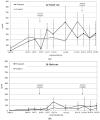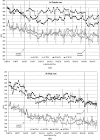Sex Differences in Physiological Acclimatization after Transfer in Wistar Rats
- PMID: 26479007
- PMCID: PMC4494431
- DOI: 10.3390/ani4040693
Sex Differences in Physiological Acclimatization after Transfer in Wistar Rats
Abstract
Most laboratory animals used in research are vendor-bred and transferred to research facilities. Transfer procedures might have considerable and unintended effects on research results. In the present study we compared physiological and behavioral parameters before and after external and internal transfer, as well as between transferred and non-transferred Wistar rats. The impact of both external and internal transfer on body weight, plasma corticosterone levels, heart rate, blood pressure, and locomotor activity was studied in both male and female Wistar rats, taking into account the sex differences in stress responsivity. External transfer was found to decrease body weight, increase plasma corticosterone, increase activity, increase heart rate in female rats, but decrease heart rate in male rats. Parameters showed differences between the sexes and light phases. This study shows that acclimatization after transfer is sex-specific and researchers should take the sex into consideration when determining the acclimatization period. It is recommended to allow for acclimatization of at least 8 days in males and two weeks in females after external transfer and timely (2 days before starting experiments) transfer the animals internally to the testing room.
Keywords: acclimatization; blood pressure; corticosterone; heart rate; locomotor activity; rat; transfer; transportation.
Figures




Similar articles
-
The impact of transportation on physiological and behavioral parameters in Wistar rats: implications for acclimatization periods.ILAR J. 2012;53(1):E82-98. doi: 10.1093/ilar.53.1.82. ILAR J. 2012. PMID: 23382273
-
Morphine sex-dependently induced place conditioning in adult Wistar rats.Eur J Pharmacol. 2008 Mar 17;582(1-3):78-87. doi: 10.1016/j.ejphar.2007.12.010. Epub 2007 Dec 23. Eur J Pharmacol. 2008. PMID: 18191832
-
Acclimatization of rats after ground transportation to a new animal facility.Lab Anim. 2007 Apr;41(2):255-61. doi: 10.1258/002367707780378096. Lab Anim. 2007. PMID: 17430625 Clinical Trial.
-
Establishing an appropriate period of acclimatization following transportation of laboratory animals.ILAR J. 2006;47(4):364-9. doi: 10.1093/ilar.47.4.364. ILAR J. 2006. PMID: 16963816 Review.
-
Stress during adolescence enhances locomotor sensitization to nicotine in adulthood in female, but not male, rats.Horm Behav. 2004 Nov;46(4):458-66. doi: 10.1016/j.yhbeh.2004.05.004. Horm Behav. 2004. PMID: 15465532
Cited by
-
Maximizing the success of bile duct cannulation studies in rats: recommendations for best practice.Lab Anim. 2017 Oct;51(5):457-464. doi: 10.1177/0023677217698001. Epub 2017 Mar 17. Lab Anim. 2017. PMID: 28948900 Free PMC article.
-
Response: Commentary: Supplier-dependent differences in intermittent voluntary alcohol intake and response to naltrexone in Wistar rats.Front Neurosci. 2016 Sep 30;10:442. doi: 10.3389/fnins.2016.00442. eCollection 2016. Front Neurosci. 2016. PMID: 27746715 Free PMC article. No abstract available.
-
Commentary: Supplier-dependent differences in intermittent voluntary alcohol intake and response to naltrexone in Wistar rats.Front Neurosci. 2016 Mar 7;10:82. doi: 10.3389/fnins.2016.00082. eCollection 2016. Front Neurosci. 2016. PMID: 27013944 Free PMC article. No abstract available.
-
What's wrong with my experiment?: The impact of hidden variables on neuropsychopharmacology research.Neuropsychopharmacology. 2022 Jun;47(7):1285-1291. doi: 10.1038/s41386-022-01309-1. Epub 2022 Mar 25. Neuropsychopharmacology. 2022. PMID: 35338255 Free PMC article. Review.
-
Effects of Transfer from Breeding to Research Facility on the Welfare of Rats.Animals (Basel). 2014 Dec 3;4(4):712-28. doi: 10.3390/ani4040712. Animals (Basel). 2014. PMID: 26479008 Free PMC article.
References
-
- Shim S., Lee S., Kim C., Kim B., Jee S., Lee S., Sin J., Bae C., Woo J.M., Cho J., et al. Effects of air transportation cause physiological and biochemical changes indicative of stress leading to regulation of chaperone expression levels and corticosterone concentration. Exp. Anim. 2009;58:11–17. doi: 10.1538/expanim.58.11. - DOI - PubMed
LinkOut - more resources
Full Text Sources
Other Literature Sources

